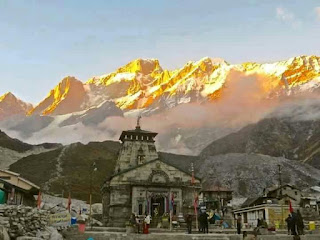Shri Kedarnath Dham
The temple is located on the Garhwal Himalayan range near the Mandakini river in the state of Uttarakhand , India.
Due to extreme weather conditions the temple is open to general public only between the months of April( Akshaya Tritiya) and November ( Kartik Purnima, the autumn full moon).
During the time of winter the deity which is called Vigraha of the temple is carried down to Ukhimath to be worshipped for the next six months. Kedarnath is seen as a homogenous form of Shiva the lord of Kedarnath the historical name of the region.
History of The Kedarnath
The Kedarnath temple is built of massive stone slabs over a large rectangular platform. the temple is ascended through the large grey steps which leads to the holy sanctum. Inscriptions has been written on Pali language on the steps. The inner walls of the sanctum are adorned with figures of various deities and scenes from mythology.
The origin of Kedarnath has been traced from The Mahabharat. According to the legends, after winning the battle of Mahabharat against the Kauravas, the Pandavas sought blessings of Lord Shiva to atone their sins of killing men during the war. They wished to atone for the sins of committing fratricide ( Gotra Hatya) and the killing of Brahmanas- the priest class (Brahmahatya) during the war. Thus they handed over the reins of their kingdom to their kin and left in search of the lord Shiva and to seek his blessings. First they went to the holy city of Varanasi believed to be Shivas favorite city known for its Kashi Vishwanath Temple.
Kedarnath temple during the time of sunrise
Lord Shiva eluded them repeatedly and while fleeing from them took refuge at Kedarnath in the form of buffalo. On being followed by the Pandavas, he dived into ground at the exact place where the Holy Sanctum is now present, leaving behind his hump on the floor surface, which is now visible. This hump inside the Sadashiva form. The Pujas and Archanas are performed on this manifestation by priests and pilgrims. There is a Holy Statue of Lord Shiva inside the temple, which is the portable manifestation of the Lord.
Outside the temple door, a large statue of Nandi buffalo stands as guard. The temple, has been continually renovated over the centuries.
Overview
The temple at Kedarnath presents an imposing sight, standing in middle of a wide plateau surrounded by lofty snow covered peaks. the temple was originally built in 8th century A.D. by Adi Shankaracharya and stands adjacent to site of an even earlier temple built by the Pandavas.
The temple has a Garbha Griha for worship and a Mandap, apt for assemblies of pilgrims and visitors. A conical rock formation inside the temple is worshipped as Lord Shiva in Sadashiva Form.
How to Reach
The holy city of Kedarnath is open for public views from May to October / November but the temple remains closed during the monsoon months as landslides are common.
Reach Rishikesh from wherever you are, From Rishikesh, you can take the direct shared cab/bus till Guptkashi, or do multiple shared cabs from Rishikesh to Rudraprayag then Rudraprayag to Guptkashi.
From Guptkashi, another shared cab or one of the less frequent buses till Sonprayag, spend the night at Sonprayag, then early morning leave for Gaurikund and start your 16 km trek here.
Kedarnath travel tips
- One can find mules and potters for hire. Check the official price chart.
- For safety check ID cards issued to potters and mule owners.
- When travel in monsoon, check with local authorities.
- Photography is not allowed inside the temples.
- After mid night temperature will drop into minus, so carry enough Woollens. Go 10-15days before Diwali.
Where to stay in Kedarnath?
There are a big government tented colony consisted of tents, cottage and rooms just before Kedarnath is operated by GMVN, which are sufficient to accommodate more than a thousand pilgrims and tourists. There are many hotels and lodges around the temple since Kedarnath is a small place. You can find a room upon reaching there.
Nowadays, many tourists take Helicopters to Kedarnath for a days visit and come back from Kedarnath the same day. They generally stay in these locations:- Phata, Rampur, Gaurikund, Sitapur, Sonprayag, Guptkashi, etc. For more datails Check hotels in Kedarnath.





Comments
Post a Comment